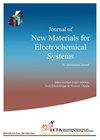Effect of Calcination Temperature on the Morphology, Crystallinity, and Photocatalytic Activity of ZnO/TiO2 in Selenite Photoreduction from Aqueous Phase
IF 0.6
4区 材料科学
Q4 ELECTROCHEMISTRY
Journal of New Materials For Electrochemical Systems
Pub Date : 2022-12-31
DOI:10.14447/jnmes.v25i4.a05
引用次数: 13
Abstract
In this study, ZnO/TiO2 was synthesized using the sol-gel method. The effect of calcination temperature was investigated on the morphology, crystal size, and influence on the photoreduction of selenite from the aqueous phase. The ZnO/TiO2 was calcined at 150 C, 350 C, and 500 C for 2 hours. The samples were characterized using SEM/EDX, XRD, and FT-IR for morphology/elemental composition, crystal structure/size, and functional group. The crystallite sizes were found to be 21.61 nm, 22.22 nm, and 24.80 nm for the temperatures, respectively. The composite morphology was found to be agglomerated granular particles that increase in agglomeration as the temperature increases. EDS results give the composition of Ti, Zn, and O2 in all samples, indicating the presence of ZnO and TiO2. XRD spectra were used to confirm the hexagonal and tetrahedral phase structure of the ZnO and TiO2. Photocatalysis experiment was conducted at pH 4 and 1 mg/L ZnO/TiO2 with 20 ppm initial concentration for 22 hrs under UV- irradiation. The catalyst calcined at 150 C showed 100% photoreduction of selenite to total selenium, while samples calcined at 350 C and 500 C showed 79% and 17%, respectively.煅烧温度对亚硒酸盐水相光还原ZnO/TiO2形貌、结晶度和光催化活性的影响
本研究采用溶胶-凝胶法合成了ZnO/TiO2。研究了煅烧温度对亚硒酸盐的形貌、晶体尺寸的影响,以及对水相光还原亚硒酸酯的影响。将ZnO/TiO2在150℃、350℃和500℃下煅烧2小时。使用SEM/EDX、XRD和FT-IR对样品的形态/元素组成、晶体结构/尺寸和官能团进行了表征。对于温度,发现晶粒尺寸分别为21.61nm、22.22nm和24.80nm。发现复合材料的形态是团聚的颗粒,其团聚随着温度的升高而增加。EDS结果给出了所有样品中Ti、Zn和O2的组成,表明存在ZnO和TiO2。XRD光谱证实了ZnO和TiO2的六方和四面体相结构。在pH4、初始浓度为20ppm的ZnO/TiO2浓度为1mg/L的条件下,在紫外光照射下进行了22小时的光催化实验。在150℃煅烧的催化剂显示亚硒酸盐对总硒的光还原率为100%,而在350℃和500℃煅烧的样品分别显示79%和17%。
本文章由计算机程序翻译,如有差异,请以英文原文为准。
求助全文
约1分钟内获得全文
求助全文
来源期刊

Journal of New Materials For Electrochemical Systems
ELECTROCHEMISTRY-MATERIALS SCIENCE, MULTIDISCIPLINARY
CiteScore
1.90
自引率
0.00%
发文量
33
审稿时长
>12 weeks
期刊介绍:
This international Journal is intended for the publication of original work, both analytical and experimental, and of reviews and commercial aspects related to the field of New Materials for Electrochemical Systems. The emphasis will be on research both of a fundamental and an applied nature in various aspects of the development of new materials in electrochemical systems.
 求助内容:
求助内容: 应助结果提醒方式:
应助结果提醒方式:


